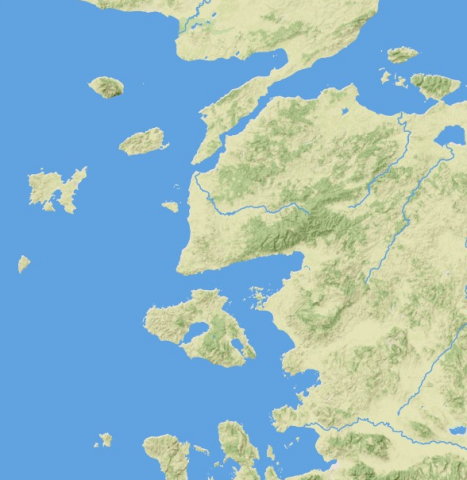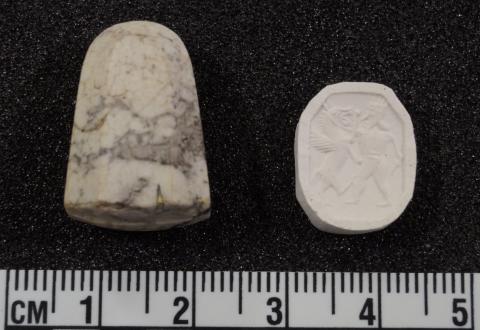Week 4 - Cultural Hybridity and "Glocalization"
Essay: Is ‘glocalization’ a helpful model for understanding elite material culture in Asia Minor during the fifth and fourth centuries BC?
Presentation 1: Lycian dynastic tombs
Presentation 2: Local coinages in Asia Minor and Phoenicia
Introductory:
K. Vlassopoulos, Greeks and Barbarians (2013) 243-273 (and 19-32 for the theoretical models of globalisation/glocalization)
E. Dusinberre, Empire, Authority and Autonomy in Achaemenid Anatolia (2013), 99-101 (Meydancıkkale), 189-206 (Lycian and Carian elite tombs)
M. Brosius, 'Keeping up with the Persians', in E. Gruen (ed), Cultural Identity in the Ancient Mediterranean (2011), 135-49.
C. Tuplin, 'The limits of Persianization', in E. Gruen (ed), Cultural Identity in the Ancient Mediterranean (2011), 150-82
P. Briant, From Cyrus to Alexander 667-73, 697-713
Mysian sarcophagi:
C.B. Rose, The Archaeology of Greek and Roman Troy (2014), 72-103 (Polyxena sarcophagus), 129-42 (Çan sarcophagus)
J. Ma, 'Mysians on the Çan Sarcophagus? Ethnicity and Domination in Achaimenid Military Art' Historia 57.3 (2008), 243-254.
Lycian tombs:
C. Draycott, 'Dynastic Definitions: differentiating status claims in the archaic pillar tomb reliefs of Lycia', in Anatolian Iron Ages 6 (2007), 103-134.
T. Sare, 'The sculpture of the heroon of Perikle at Limyra', Anatolian Studies 63 (2013) 55-74.
The Hekatomnids of Caria, and the Pixodaros inscription from Xanthos:
S. Hornblower, Mausolus (1982), 34-52, 137-170.
A.M. Carstens, Karia and the Hekatomnids (2009), esp. 121-126.
P.J. Rhodes and R. Osborne, Greek Historical Inscriptions 404-323 BC (2003), nos. 54-6 (inscriptions relating to Mausolus); no. 78 (Xanthos)
P. Briant, ‘Cities and satraps in the Achaemenid empire: Xanthos and Pixodaros’, in Kings, Countries, Peoples (2017) 99-127.
Coins:
M. Alram, ‘The Coinage of the Persian Empire’, in W.E. Metcalf (ed), The Oxford Handbook of Greek and Roman Coinage (2012), 61-87.



Coins T1 to T3 were struck by successive members of the native Hekatomnid satrapal dynasty of Caria. T1 (Maussollos) and T2 (Idrieus) come from the 1929 Fethiye hoard (IGCH 1266), buried c. 340 BC, which contained 67 silver tetradrachms, 49 of Ephesos, 1 of Kos, 12 in the name of Maussollos, and 5 in the name of Idrieus. The obverse type of the three quarter facing bust of Apollo (all three coins) may be imitating the Arethusa-head tetradrachms of Syracuse in Sicily; at any rate, this divine portrait is characteristically Greek in style. The deity on the reverse is Zeus Labraundeus, worshipped at the sanctuary of Labraunda near Mylasa, a site which was heavily monumentalised by the Hekatomnids in the fourth century BC. All three satraps have Carian names, and the deity on the reverse is a native Carian Zeus, but the language and iconography of the coins is purely Greek. Note the absence of any explicit Achaemenid iconographic elements. See - K. Konuk, ‘Coinage and Identities under the Hekatomnids’, in O. Henry ed., 2010, 4th Century Karia, 101-122; K. Vlassopoulos, Greeks and Barbarians, 2013, 255-260.
The coinage T4 was struck in large quantities somewhere in western Asia Minor (perhaps in Caria) between c. 360 BC and the end of Achaemenid rule in 334 BC. The Achaemenid-style types (note especially the archer-king on the obverse) and the absence of a legend strongly suggest that this was a true Achaemenid royal coinage, like the earlier darics and sigloi. The production of sigloi dropped substantially in the earlier fourth century, and it is likely that the royal mints in Asia Minor eventually moved over to the production of these Chian-weight coins as a reaction to the efflorescence of Chian-weight civic and satrapal coinages in the region in the mid-fourth century BC (e.g. the satrapal coinage of the Hekatomnids of Caria). See A. Meadows in Coin Hoards IX, 210-212; A. Meadows, ‘The Chian revolution’, in Th. Faucher et al., Nomisma, 2011, 273-295

Meydancıkkale is an important Achaemenid fortress in western Cilicia, with unusually strongly 'Persianising' architecture and relief sculpture.
T10 and T11 represent two stater-types struck at Tarsos in the late 5th / early 4th centuries BC, as part of a huge and varied local coinage with a bewildering variety of native Cilician, Persian, and Greek-style iconography (O. Casabonne, La Cilicie à l’époque achéménide (2004) 123-131: these coins are Types D3 and F10). The types are strongly militaristic, and probably indicate that the coins were struck to pay troops. The Greek hoplite on the later coin could either be an image of a Greek mercenary in Persian service, or (more likely) represents a generic Greek opponent to the idealised Persian cavalryman on the obverse. Compare the Achaemenid chalcedony scaraboid seal from Bolsena.
Coins with the types of T12 and T13 were struck c. 384-383 BC by the Persian general Tiribazos at four Cilician cities, Mallos, Tarsos, Issos and Soloi. They were probably intended to finance the Persian campaign against Evagoras of Salamis on Cyprus (P. Briant, From Cyrus to Alexander (2004) 646-652). The combination of Greek and Aramaic legends (for the city and Persian general respectively) is unparalleled elsewhere. The image on the reverse surely depicts Ahura Mazda, but the deity is depicted nude in Greek style; the wreath with which he is crowning himself is also a purely Hellenic iconographic element. See P. Briant, From Cyrus to Alexander (2002) 1013; K. Vlassopoulos, Greeks and Barbarians (2013) 270; O. Casabonne, La Cilicie à l’époque achéménide (2004) 188-193.
Coins of the type represented by T14 were struck by Pharnabazos, satrap of Hellespontine Phrygia, during the period when he served as commander of the Persian forces mustering in the Levant for an unsuccessful attempt to recapture Egypt (Diodorus 15.29; P. Briant, From Cyrus to Alexander (2002) 652-655; O. Casabonne, La Cilicie à l’époque achéménide (2004) 194-196). The identity of the male military figure on the reverse is unclear: an idealised portrait of Pharnabazos? A generic Greek mercenary? The Cilician war-god Sanda? On any hypothesis, the Hellenic style of the portrait is remarkable. Note also the presence of the name of the Achaemenid province of Cilicia on the reverse: what function does this serve?
T15 represents a series of coins struck in vast quantities at Tarsos in the name of a certain Tarkumuwa, probably in the 370s BC. Tarkumuwa is unattested elsewhere, but he carries an indigenous Cilician name (derived from the name of the old Anatolian storm-god Tarhunt); he was probably a local Cilician dynast, appointed as satrap of Cilicia by Artaxerxes II (compare the local Hekatomnid satrap-dynasty in Caria). The reverse type, depicting a generic Persian figure in anaxyrides, kandys, and bashlyk, testing the straightness of an arrow or a bow, is relatively common on ‘Greco-Persian’ seals and gems (J. Boardman, Greek Gems and Finger Rings (1970) 317, fig. 294), and recurs on Parthian coins of the Hellenistic period (P. Thonemann, The Hellenistic World: Using Coins as Sources (2015) 92). See O. Casabonne, La Cilicie à l’époque achéménide (2004) 174-181.
Silver staters such as T16 and T17 were struck at Tarsos in vast quantities by the last Persian satrap of Cilicia, Mazaios, a prominent courtier of Darius III who transferred his loyalty to Alexander after Gaugamela; he was Alexander’s first satrap at Babylon (for a biography, see W. Heckel, Who’s Who in the Age of Alexander the Great (2009) 156-157). The obverse type of Mazaios’ Cilician coinage was reworked by Alexander for his own silver coinage, probably initiated shortly after the battle of Issos in 333 BC (P. Thonemann, The Hellenistic World: Using Coins as Sources (2015) 13).


Coins T31 and T32 were struck in the twilight of the Achaemenid Empire, shortly after Artaxerxes III Ochus regained control of rebellious Egypt ca.346/5 BCE. These follow a longer tradition in Egypt of striking 'imitations' of Athenian 'owl' coins. For more context, see H. P. Colburn (2020) Archaeology of Empire in Achaemenid Egypt, Chapter 6.



![Image for "Harpy" Tomb, c. 470 BC [in situ]](https://www.cabinet.ox.ac.uk/sites/default/files/styles/large/public/images/sources/8814470333_bb26d0307f_k.jpg?itok=8wDF3k5H)
![Image for Clone of Clone of Karaburun Tumulus II Painting [Reclining diner]](https://www.cabinet.ox.ac.uk/sites/default/files/styles/large/public/images/sources/Karaburun.png?itok=_Hfv3w59)


![Image for Clone of T7: Silver stater in the name of the Lycian dynast Kuprlli of Xanthos, c. 480-420 BC. [Obverse]](https://www.cabinet.ox.ac.uk/sites/default/files/styles/large/public/images/sources/0045199o.jpg?itok=v5qFDiOE)
![Image for Clone of T8: Silver stater in the name of the Lycian dynast Mithrapata of Antiphellos, c. 390-360 BC. [Obverse]](https://www.cabinet.ox.ac.uk/sites/default/files/styles/large/public/images/sources/0045202o.jpg?itok=gOpF6k8k)
![Image for Clone of T9: Silver stater in the name of the Lycian dynast Perikles of Limyra, c. 390-360 BC. [Obverse]](https://www.cabinet.ox.ac.uk/sites/default/files/styles/large/public/images/sources/0045201o.jpg?itok=SVPwEjaD)

![Image for Çan Sarcophagus, 1st quarter of 4th century BC. [View 1]](https://www.cabinet.ox.ac.uk/sites/default/files/styles/large/public/images/sources/10506987054_112a460859_o.jpg?itok=pCRuHHFf)

![Image for Clone of T2: Silver tetradrachm in the name of Idrieus, satrap of Caria (351-344 BC). [Obverse]](https://www.cabinet.ox.ac.uk/sites/default/files/styles/large/public/images/sources/0045194o.jpg?itok=8D4B7FAA)
![Image for Clone of T3: Silver didrachm in the name of Pixodaros, satrap of Caria (340-335 BC). [Obverse]](https://www.cabinet.ox.ac.uk/sites/default/files/styles/large/public/images/sources/0045195o.jpg?itok=NaccLrhg)
![Image for Clone of T4: Silver tetradrachm struck in western Asia Minor (?), c. 341-334 BC. [Obverse]](https://www.cabinet.ox.ac.uk/sites/default/files/styles/large/public/images/sources/0045196o.jpg?itok=3rIXv1km)


![Image for Clone of T10: Silver stater struck at Tarsos, c. 420-410 BC. [Obverse]](https://www.cabinet.ox.ac.uk/sites/default/files/styles/large/public/images/sources/0045203o.jpg?itok=I5ZPW2gk)
![Image for Clone of T11: Silver stater struck at Tarsos, c. 410-385 BC. [Obverse]](https://www.cabinet.ox.ac.uk/sites/default/files/styles/large/public/images/sources/0045204o.jpg?itok=TB78T8DZ)
![Image for Clone of T12: Silver stater struck at Mallos in the name of the general Tiribazos, c. 384-383 BC. [Obverse]](https://www.cabinet.ox.ac.uk/sites/default/files/styles/large/public/images/sources/0045206o.jpg?itok=fHlTtLnw)
![Image for Clone of T13: Silver stater struck at Tarsos in the name of the general Tiribazos, c. 384-383 BC. [Obverse]](https://www.cabinet.ox.ac.uk/sites/default/files/styles/large/public/images/sources/0045205o.jpg?itok=QqavIyOR)
![Image for Clone of T14: Silver stater struck at Tarsos in the name of the general Pharnabazos, c. 380-373 BC. [Obverse]](https://www.cabinet.ox.ac.uk/sites/default/files/styles/large/public/images/sources/0045207o.jpg?itok=5Gr0HpEF)
![Image for Clone of T15: Silver stater struck at Tarsos in the name of Tarkumuwa, c. 380-370 BC. [Obverse]](https://www.cabinet.ox.ac.uk/sites/default/files/styles/large/public/images/sources/0045208o.jpg?itok=diJNUgJn)
![Image for Clone of T16: Silver stater struck at Tarsos in the name of the satrap Mazaios, c. 361-333 BC. [Obverse]](https://www.cabinet.ox.ac.uk/sites/default/files/styles/large/public/images/sources/0045210o.jpg?itok=oJOTtK2_)
![Image for Clone of T17: Silver tetradrachm struck at Tarsos in the name of Alexander the Great, c. 333-327 BC. [Obverse]](https://www.cabinet.ox.ac.uk/sites/default/files/styles/large/public/images/sources/AlTarsusObv.jpg?itok=FhDVZa6F)

![Image for Clone of Clone of T26: Silver dishekel, struck at Sidon in the name of Tennes, c. 354-348 BC. [Obverse]](https://www.cabinet.ox.ac.uk/sites/default/files/styles/large/public/images/sources/0045176r.jpg?itok=2GpVfKQ_)
![Image for Clone of T27: Silver dishekel, struck at Sidon in the name of the satrap Mazaios, 336/5 BC. [Obverse]](https://www.cabinet.ox.ac.uk/sites/default/files/styles/large/public/images/sources/0045177r.jpg?itok=Vb0RVkH0)
![Image for Clone of T28: Silver sixteenth-shekel, struck at Sidon in the name of the satrap Mazaios, 336/5 BC. [Obverse]](https://www.cabinet.ox.ac.uk/sites/default/files/styles/large/public/images/sources/0045178r.jpg?itok=M8eNsWT9)
![Image for Clone of T29: Silver dishekel, struck at Tyre, c. 430 BC. [Obverse]](https://www.cabinet.ox.ac.uk/sites/default/files/styles/large/public/images/sources/0045179o.jpg?itok=sfODcCZ6)
![Image for Clone of T30: Silver shekel, struck at Tyre, c. 425-394 BC. [Obverse]](https://www.cabinet.ox.ac.uk/sites/default/files/styles/large/public/images/sources/0045180o.jpg?itok=W5yk0aYk)
![Image for Clone of T31: Silver Athenian owl imitation, struck by the Egyptian satrap Sabakes, c.340-333 BC. [Obverse]](https://www.cabinet.ox.ac.uk/sites/default/files/styles/large/public/images/sources/0045189o.jpg?itok=Mm1R6tj2)
![Image for Clone of T32: Silver Athenian owl imitation, struck by the satrap Mazakes, (?) 331-323 BC (or earlier). [Obverse]](https://www.cabinet.ox.ac.uk/sites/default/files/styles/large/public/images/sources/0045190o.jpg?itok=WD29JC-n)


